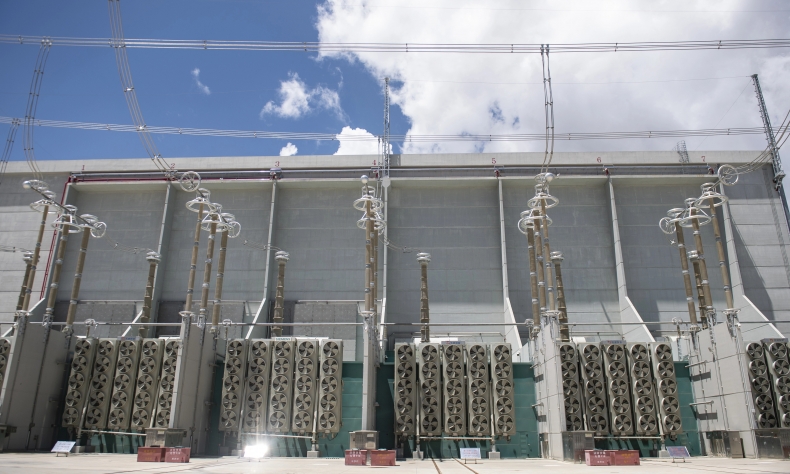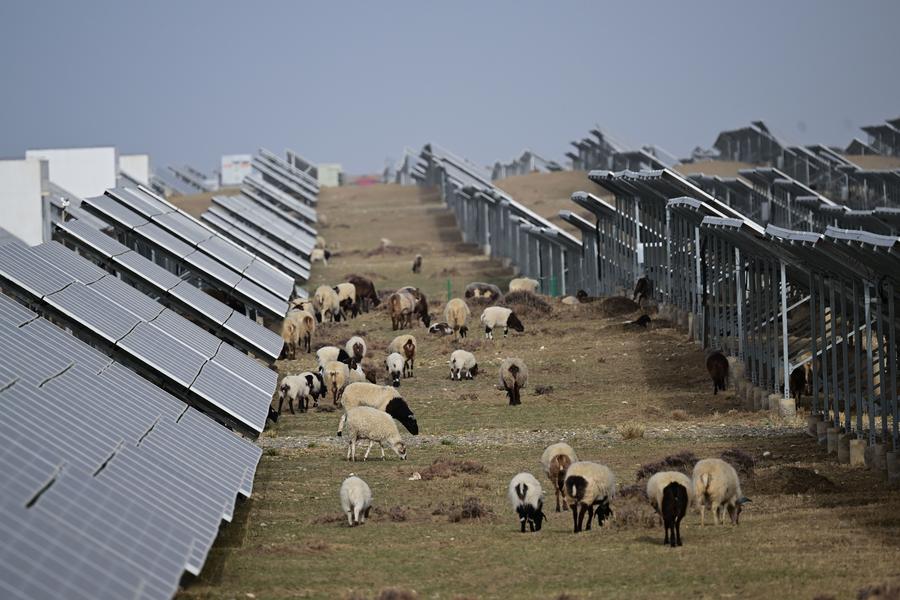The Great Energy Gambit

Qinghai’s clean energy industry is developing rapidly.
In just 5 milliseconds—0.005 seconds—clean energy generated in Qinghai Province, northwest China, travels over 1,500 km to the central province of Henan.
“In the blink of an eye, Qinghai has already sent electricity to Henan multiple times,” Lu Jinlong, a technician at the Qingnan Converter Station in Gonghe County, Hainan Tibetan Autonomous Prefecture, Qinghai, told reporters during a group interview on July 25.
The Qingnan Converter Station is the starting point of the Qinghai-Henan ±800-kilovolt (KV) ultra-high-voltage direct current (UHVDC) project. Ultra-high voltage transmission lines, operating at over 800 KV of direct current (DC) or 1,000 KV of alternating current (AC), offer advantages over traditional lines, including increased transmission capacity, extended distances and reduced energy losses.
Operational since 2020, the project transmits 40 billion kilowatt-hours (kwh) of electricity annually, serving as a vital channel for Qinghai’s clean energy export. The 1,587-km line traverses Gansu and Shaanxi provinces before reaching Zhumadian in Henan.
The Qingnan Converter Station collects clean energy, including solar and wind power, from the surrounding areas. Utilizing conversion technology, it transmits this energy to Henan via the Qinghai-Henan UHVDC transmission line.
The critical element of this long-distance transmission is the conversion of AC to DC. The latter’s linear current flow minimizes energy loss. The converter station transforms the AC electricity it has gathered into UHVDC, allowing green electricity to travel efficiently.
The efficient, long-distance transmission of green electricity is underpinned by the rapid development of Qinghai’s clean energy industry. Situated in the northeastern part of the Qinghai-Xizang Plateau, Qinghai possesses a comprehensive spectrum of clean energy resources, with its hydropower, wind power and solar energy reserves ranking among the highest in China.
As of June this year, the province’s installed clean energy capacity had reached 71.53 gigawatts (GW), constituting 94.23 percent of its total power capacity. In the first half of this year, clean energy generation in Qinghai amounted to 53.23 billion kwh, representing 89.88 percent of the province’s total electricity output.

Solar power station
Some of the electricity transmitted by the Qingnan Converter Station originates from the nearby Tala Gobi Desert. Here, in a spectacular display, rows upon rows of photovoltaic (PV) panels stretch across the desert landscape. This is a glimpse into the Gonghe County PV Industrial Park in Hainan Tibetan Autonomous Prefecture.
The Tala Gobi Desert, located at an average altitude of nearly 3,000 meters, was once largely barren, plagued by extreme drought and desertification. During sandstorms, swirling dust blotted out the sun, choking towns over 100 km downwind with dense, particulate-laden air.
In 2011, Huanghe Hydropower Development Co. Ltd., a subsidiary of energy giant State Power Investment Corp., initiated the development of the PV industrial park in the desert, which had been selected for its abundant sunshine, low annual rainfall and dry climate, ideal conditions for solar power plant construction. Today, the industrial park has expanded to 609 square km, becoming the world’s largest solar power generation park.
The installation of PV panels not only paved the way for clean energy development but also, unexpectedly, fostered ecological restoration.
Perched on tilted mounting frames, the solar panels serve a dual purpose: generating clean energy while acting as windbreakers that slow desert winds and shield the soil from excessive evaporation.
Yet the region’s relentless sandstorms leave their mark—layer upon layer of dust accumulating on panel surfaces, steadily sapping their power-generating potential. Maintenance crews wage a constant battle against the encroaching grit, using targeted water sprays to wash away the abrasive particles.
In a clever ecological twist, the solar park now cultivates hardy native vegetation beneath the panels. These drought-resistant plants, carefully selected for the local environment, help anchor the soil while reducing the need for panel washings. What was once barren wasteland has gradually transformed into a verdant sea of grass swaying between the gleaming solar arrays, proving that energy production and ecological restoration can work hand in hand.
To maintain optimal solar efficiency while mitigating fire risks, the park has implemented an ingenious ecological solution: seasonal grazing rights. From June through October each year, local herders are invited to bring their flocks to forage beneath the solar arrays at no cost. The sheep serve as natural lawnmowers, keeping vegetation at an ideal height—low enough to prevent panel shading and fire hazards, yet sufficient to protect the soil.
This symbiotic relationship yields multiple benefits. As the sheep graze, their droppings fertilize the land, enriching the soil naturally.

Green computing
Alongside its clean electricity expansion, Qinghai is striving to become a national leader in green computing development.
Green computing encompasses the environmentally sustainable design, development, use and disposal of computing systems. Its primary objective is to minimize the carbon footprint of these systems while ensuring their optimal performance.
The accelerating development of AI and large language models is continuously fueling the demand for computing power, which in turn necessitates increased electricity consumption. Qinghai is actively addressing this by promoting the application of clean energy in computing, thereby transforming green electricity into green computing power, and fostering the integrated development of clean energy with the digital economy.
To achieve this, the Qinghai Clean Energy and Green Computing Power Dispatch Center, located in Xining, the provincial capital, and established by the State Grid Qinghai Electric Power Co. last June, centralizes the relevant data from clean energy power stations and computing centers across the province.
Zhou Ji, a technician at the Digitalization Department of the company, explained to reporters during a group interview on July 21 that the center has developed a sophisticated big data model. This model provides computing companies with precise electricity usage guidance, enabling them to execute energy-intensive computing tasks during periods when renewable energy is most abundant and electricity prices are at their lowest.
This strategic approach contributes to energy conservation, emissions reduction and the generation of green computing power.
He further noted that the dispatch center currently integrates computing power and power consumption data from five data centers, including those operated by the country’s three major telecom providers—China Mobile, China Unicom and China Telecom—as well as Qinghai University. Plans are now underway to connect with additional data centers across the province.
Qinghai’s commitment to green computing has also attracted major Internet firms, such as e-commerce giant Alibaba and Baidu—China’s leading technology company and the dominant search engine in the Chinese market, to establish and develop computing centers within the province.
 Facebook
Facebook
 Twitter
Twitter
 Linkedin
Linkedin
 Google +
Google +










